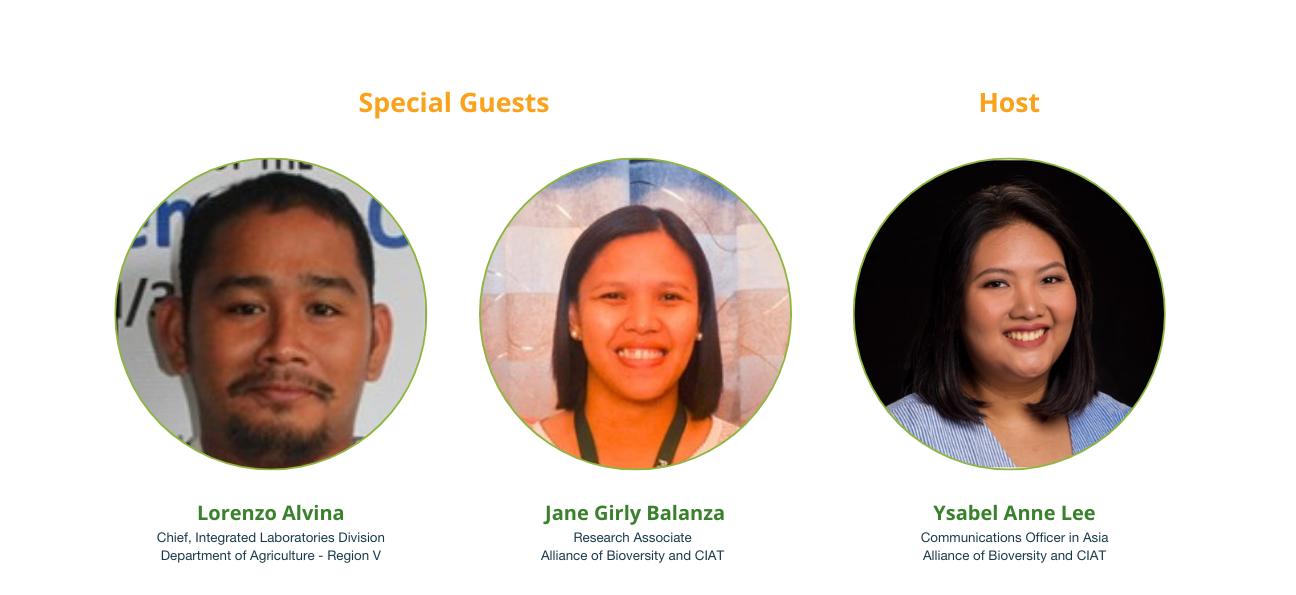From the Field Podcast: Facing a new normal for agricultural extension in Bicol Region, Philippines

For the International Day for Disaster Risk Reduction, listen in as we visit one of the Philippines’ typhoon hotspots. We spoke with our colleagues to discuss how we are laying the foundation for evidence-based, localized climate information services in the wake of the pandemic. The full podcast is available here.
By: Sophia Romilla
Climate change means increasingly unpredictable and extreme weather conditions, with farmers some of the worst affected. This is especially true in countries such as the Philippines, where intense typhoons pose a grave threat to lives and livelihoods.
Recognizing this, the government has focused on developing climate-resilient agriculture, in which farmers are encouraged to apply sustainable and adaptive agricultural practices to achieve long-term productivity and farm incomes under varied conditions. To achieve this, new strategies and technologies for climate change adaptation should be considered. This includes strengthening disaster risk reduction and management, investing in a climate resilience toolkit, and collaborating with the local government and partner institutions in developing climate-resilient programs and activities.
In this podcast, the Alliance spoke with a partner in the Philippines, Lorenzo Alvina, Chief of the Integrated Laboratories Division at the Department of Agriculture (DA) Region 5 and current focal point for Climate Change Adaptation and Disaster Risk Reduction in the region, and Jane Girly Balanza, Research Associate at the Alliance of Bioversity International and CIAT. They highlighted the importance of partnerships in building climate-resilient agriculture at the local level, and discussed how their approaches have evolved over the last few years.
Listen to the Podcast

How the pandemic shaped regional agricultural extension
At the beginning of the pandemic in March 2020, the COVID-19 surge limited everyone’s movement, resulting in a lack of public transportation, limited access to goods and services, and stable income. For agricultural extension, Alvina explains that it was difficult to travel during the first year of the pandemic due to varying protocols from different local governments. One big change in extension work is that meetings moved into digital platforms and this has been the norm since.
For farmers, the pandemic posed a greater challenge in accessing agricultural services due to their limited access to the internet. But there weren’t many viable options back then, forcing some agriculture extension services to shift to online platforms where their projects and programs could be accessed. Alvina acknowledged that the new platform is relatively complex for the farmers to access, so the support of regional offices and local government units were able to help augment the gap in technology.
Climate-resilience practices in the region
Region 5, or Bicol Region, is known to be vulnerable to extreme weather conditions, specifically typhoons and drought. Disaster risk reduction and management is being operationalized in various forms depending on the resources per province, municipality, and city. Alvina says:
“If you ask Local Government Units in terms of priorities, they would rather prioritize saving lives than livelihoods, right? Advocacy for disaster risk reduction, specifically for the agricultural sector, becomes only apparent during times of crisis.”
Despite the challenges in prioritizing disaster risk management in the agriculture sector, DA Region 5 is doing its part in building a climate-resilient agriculture in the region: this includes agricultural extension activities that provide farm, climate, and early warning advisories for the farmers. They also utilize different tools for damage assessment in times of climate crisis. The pandemic-induced shift to digital tools is helpful in estimating extent of damages and losses in the agricultural sector during disaster events.
Another initiative of DA in Region 5 is capitalizing on climate information services, particularly helping the farmers have access to relevant forecasts and have a layer on financial services. Explains Balanza:
“We add climate lens [to existing platforms] inclusive of science-based solutions where we can ensure better access to private and public finance in terms of availing insurance or releasing cash transfers to farmers.”
Working with the Alliance to achieve a climate-resilient agriculture
Alvina is happy that the partnership with the Alliance is offering a new perspective on how to improve climate information services in the region.
Through partnerships with the Alliance and other institutions, Alvina says, “we finally finished the CRVA (climate risk and vulnerability assessment) which is being used now by the Philippine Rural Development Project.” Information from the CRVA is being used in the provincial planning process to identify commodity investment planning.
In addition, agricultural extension officers are currently working on the integration of weather and climate data that they can get from the different automated weather stations to consolidate data. Alvina is hopeful that the Alliance may be able to integrate this data in future climate information-related materials and platforms.
Balanza explains that a key methodology the Alliance is proud of is marrying weather and climate data with socioeconomic data and spatial data. This introduces a localized approach in targeting relevant interventions and solutions in a specific area at a given time.
For Alvina, the next step in institutionalizing and scaling climate information services beyond one region is to establish policies and prioritize climate change adaptation and disaster risk reduction in the agriculture sector. He says:
“It’s a long way to go, [but in terms] of data availability, we can readily show [policy makers] that because process that we’ve taken, and projects that we’ve done, the data is readily available for them.”
The Alliance is currently working on developing climate information services for the agriculture sector in Region 5, using climate and weather data from the state weather bureau, PAGASA. Working with the Department of Agriculture, the Alliance hopes to pilot this platform as support to the existing work on climate resilient agriculture in the Philippines.

